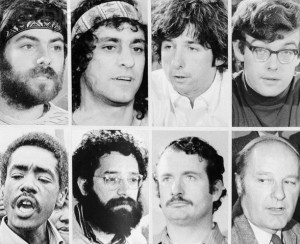Everybody who knew Tom Hayden probably has a story about him. His life was filled with drama. His immense intellectual curiosity and his courageous willingness to explore many avenues for social change: outside and inside; short term and long-term put him at the forefront in many of the most important social change battles of our time.
 As a boy growing up in the Midwest, Tom was a distant, but romantic figure to me. I first heard about him listening to CBS radio news coverage of the trial of the “Chicago Seven” (Eight – if you count Bobby Seale) who were on trail for conspiracy to disrupt the 1968 Democratic Convention.
As a boy growing up in the Midwest, Tom was a distant, but romantic figure to me. I first heard about him listening to CBS radio news coverage of the trial of the “Chicago Seven” (Eight – if you count Bobby Seale) who were on trail for conspiracy to disrupt the 1968 Democratic Convention.
As a teen, I read the Port Huron Statement, wrote about it for an English class, and like so many others was inspired by the bold challenge to America’s military industrial establishment and the call to resist relentlessly and build a truly democratic society.
Over the years, I followed Tom Hayden’s legislative career and read a few of his 25 books. He even visited our Global Exchange peace house on a trip to Chiapas while he was a California State Senator. But, I didn’t meet him until in the heat of the Iraq war resistance when we worked together to build support for US soldiers fleeing to Canada rather than fight in what they had determined to be an immoral war.
 In late 2004, after the re-election of George W Bush, things looked bleak for the peace movement. The Iraq War seemed destined to continue indefinitely. I got a call from Tom who was interested in exploring a people’s peace initiative, modeled on what he and the international peace movement had done by visiting North Vietnam in the late 1960s, helping open the door to the Paris Peace talks and the eventual de-escalation of American intervention.
In late 2004, after the re-election of George W Bush, things looked bleak for the peace movement. The Iraq War seemed destined to continue indefinitely. I got a call from Tom who was interested in exploring a people’s peace initiative, modeled on what he and the international peace movement had done by visiting North Vietnam in the late 1960s, helping open the door to the Paris Peace talks and the eventual de-escalation of American intervention.
Tom and I had contacts in Iraq who were desperate to find solutions to the crisis that was ripping apart their lives and communities. So, in early January 2006 we decided to travel together to Amman, Jordan where we could meet with Iraqis, both exiles and others like my friends from Baghdad who made the overland trip to meet us there. We had the support of Seattle area, Congressman Jim McDermott, whose friends in Amman hosted us and organized many of our meetings.
Tom was energetic and formidable. He used the Vietnam era experience to explain how US policy evolves in response to civil society pressure. Tom’s reputation as a sensible radical who had a brush with Hollywood celebrity opened many doors and conversations. We met with an amazing array of Iraqi exiles, spoke at the prestigious Arab Thought Forum and even met with the Jordanian Crown Prince at the Royal Palace.
 The people we spoke with were eager for dialogue and solutions, but as we analyzed everything we were hearing, Tom and I both became increasingly discouraged about any prospect for the peace movement being able to broker a breakthrough — given the absence of state actors or other reliable partners among the Iraqi resistance.
The people we spoke with were eager for dialogue and solutions, but as we analyzed everything we were hearing, Tom and I both became increasingly discouraged about any prospect for the peace movement being able to broker a breakthrough — given the absence of state actors or other reliable partners among the Iraqi resistance.
We knew that the US invasion had mindlessly broken Iraq and destabilized the region, but our close encounter in Amman revealed just how deep the wounds were. There was no simple way to end what we had started. The battle for Mosul, which raged 10 years later, on the last day of Tom’s life is tragic testimony to how much is left to be done.
Tom kept working to the end and never gave in to pessimism. In his last years he supported Homies Unidos in their efforts to forge peace in Los Angeles (and El Salvador). He always believed in the essential decency and redeeming, beautiful spirit of humanity.
We will miss him.
